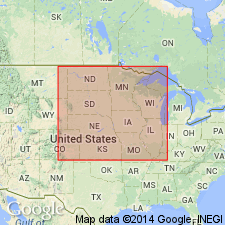
- Usage in publication:
-
- Spavinaw terrane*
- Modifications:
-
- First used
- Dominant lithology:
-
- Granite
- Rhyolite
- Dacite
- Trachyte
- Andesite
- AAPG geologic province:
-
- Midcontinent region
Summary:
A tectono-stratigraphic term [informal] used to refer to all rocks of Northeastern Oklahoma province (Washington County Volcanic Group, Spavinaw Granite Group, Osage County Microgranite) and the informal Central Oklahoma granite group mapped in subsurface by Denison (1981, Oklahoma Geological Survey Circular 84). [Washington County Volcanic Group apparently removed from St. Francois terrane]. Terrane is represented in surface by a few small outcrops of micrographic granite porphyry near Spavinaw, Mayes Co, OK. Terrane underlies most of northeastern OK, eastern KS, southwestern MO and northern AR, Midcontinent region. Volcanic rocks of terrane are mostly rhyolite (locally metamorphosed to hornfels) and minor dacite, trachyte and andesite. Volcanics occur on northern and southern flanks of Spavinaw arch which extends from central OK east-northeast 240 km into southwest MO; arch is underlain by Spavinaw Granite Group. Granites are comagmatic, intrusive phase of volcanic rocks. Terrane is 100 m.y. younger than St. Francois terrane; older than tholeiites and rhyolites of Middle Proterozoic Midcontinent rift system. U-Pb age is 1.35-1.4 Ga (Middle Proterozoic).
Source: GNU records (USGS DDS-6; Denver GNULEX).
For more information, please contact Nancy Stamm, Geologic Names Committee Secretary.
Asterisk (*) indicates published by U.S. Geological Survey authors.
"No current usage" (†) implies that a name has been abandoned or has fallen into disuse. Former usage and, if known, replacement name given in parentheses ( ).
Slash (/) indicates name conflicts with nomenclatural guidelines (CSN, 1933; ACSN, 1961, 1970; NACSN, 1983, 2005, 2021). May be explained within brackets ([ ]).

